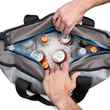Remember when you were on top of the world after you snuck a kiss on that first high-school movie date only to get the “it’s not you, it’s me” note in your locker the next morning? It was like that — one of those moments when sheer and utter happiness turned into gut-wrenching agony.
As I held the 50-pound tarpon with two hands in the cool, green waters of the Belize River, I was ecstatic. Seconds earlier, I’d handed my fishing buddy, Camden, the 10-weight fly rod I’d used to boat the chrome-armored beast so I could get my hands on the fish. Up until then, I hadn’t chased tarpon that often — here and there, with moderate success, mostly for smaller fish in backcountry locales throughout the tropics. But this mid-sized tarpon was one of the biggest I’d ever caught, and to hook and land it in this primal place, where howler monkeys screamed from the canopy and crocodiles glided through the water? Let’s just say I was pretty damned happy with myself.
In his haste to capture the moment in pixels, Camden set the rod — a 10- weight Sage SALT R8 — down against the gunnel of the boat, and leaned out over me in hopes of capturing that perfect shot. That’s when the tarpon showed that it had one more burst in it. Still hooked, it dove under the boat and ate up what little slack Camden left hanging out of the tip of the rod.
Snap!
“Dear Chris. I had a great time at Nightmare on Elm Street last night. But I just don’t see this happening. You’re a great guy, but I’m just not ready for a relationship. Good luck in the future. Michele.”
I mean, seriously. I was having such a good “big fish” day. Earlier that morning, a behemoth of a jack crevalle eagerly slammed a streamer on the flats. It ran into my backing twice and gave me everything it had. And then there was this fish, a stunning jungle tarpon that jumped into the sultry, humid evening three times and then came to hand, where it reflected the late-in-the-day tropical light ever so perfectly. Not bad for the first day of our week at Belize River Lodge.
“Oh,” I heard Camden say as he pulled back from the water. “Was that my fault?”
I was quiet as we motored back to the lodge, as was my fishing pal. I’d be fishing the rest of my trip in Belize with a loaner, and not with Sage’s new flagship saltwater offering—a rod that was going to be sorely missed.
What works
For me, a “big” rod is anything over a 7-weight. Even on the flats. I love a lighter rod when chasing bonefish, but I’ll size up to an 8- or a 9-weight if I get a shot at permit. Mostly, though, I rarely fish double-digit fly rods. I’m sure that’s partly because my tarpon fishing has been done sparingly, and largely for the smaller fish, and partly because I live in the Rockies, where a 10-weight saltwater rod might see the light of day once a year. Maybe.
But with the SALT R8, I’ve learned to embrace larger artillery, mostly thanks to technological advancements that have mitigated a lot of the tradeoffs typically associated with more powerful rods. Read on for a bit about why.
Quick-Loading
When I spotted the big jack cruising through a cut in the flats just a few clicks out from the mouth of the Belize River, it felt a bit odd for me to look at Camden and say, “Hey man. Hand me that 10-weight.” I quickly stripped the fly line off the reel as our guide for the day, John Moore, flipped the panga around so I could get a solid cast at the surly jack. One backcast and a quick flip of the Tarpon Toad later, and I was hooked up to the big fish and watching as it screamed off into the Caribbean. The rod loaded about 40 feet of fly line with relative ease and, honestly, made me feel like a better quick-fire fly caster than I likely really am.
In the SALT R8, Sage has continued the trend that we’ve seen in its predecessors, namely the SALT and SALT HD — one of maintaining or increasing recovery speed while reducing the amount of force required to load (read: bend) the rod. In the simplest terms, this translates into a softer tip that doesn’t sacrifice power, and that pays dividends not only in allowing anglers to load the road with less effort and more quickly, but in other areas as well — such as tippet protection.
Feel
Even as I tightened the drag and got in big-fish fighting mode as the jack took off into the sea, I remember thinking, “That didn’t feel like I was casting a 10-weight.” Despite being a “big game” rod, the SALT R8 is a comfortable casting rod that, so long as your technique is solid, won’t wear you out after a day spent casting. This, Sage’s marketing materials claim, is the company’s R8 technology in action.
As the technology behind the graphite and resin matrices that fly rod blanks are built from improves, it’s getting harder and harder to understand the tech sheets from rod manufacturers without a daylong Q&A session with the designers and engineers in the rod shop. For R8’s part, Sage explains its secret sauce as “a proprietary aerospace composite with a greater hoop strength [that] enables us to dimensionally grow taper diameter more quickly from the tip—while a nano-sintered resin application increases axial resilience and allows us to pack more fiber into the blank.”
Got that? Probably not.
The take home message is that in its rods with R8 Technology, Sage is using a purer form of graphite that not only allows for improved energy transfer between graphite fibers, but also improves the bonds between the graphite and the resin that is applied to form the blank material. The new graphite-resin matrix also allows for the use of less material, which translates into thinner blanks without sacrificing strength and power.
Another aspect of R8 Technology that’s particularly noteworthy is that it includes, for the first time in almost 20 years, new graphite. Over the years, Sage has developed and released a bevy of iterations of materials technology — G5, Konnetic, and KonneticHD just to name a few — but those new technologies were exclusively the result of advancements in resins and composites.
Sage goes out of its way — perhaps rightfully so — to highlight its intimate connection with the aerospace industry, largely a product of its geographical location in the Pacific northwest, home of aerospace giants like Boeing. According to Sage, the relationships they’ve forged over the years often afford them early, and sometimes exclusive, access to materials technology advances — such as the new graphite used in its R8-driven fly rods.
So what does any of this have to do with how a rod feels? Sage says that all this tech allows it to build rods that sport a much more subtle taper from tip to butt, transfer energy far better, and which move the “sweet spot” closer to the casting hand. That, in turn, makes the rod feel more like an extension of the caster’s arm.
Does some of that sound like marketing bluster? Sure. But the proof, as always, is in the way the rod casts and performs on the water. And there’s no question the Sage SALT R8 rod is a smooth operator that sports an almost ideal mix of speed and touch.
Touch
Speaking of touch, as noted, the SALT R8 is a “big” rod that doesn't feel big. When casting for tarpon on the Belize Olde River, the fishing I was doing was familiar, if a bit oversized. Casting tight to blowdowns and root wads for jungle tarpon is just plus-sized fishing for big browns on the South Fork. The rod, as power-packed as it felt when I battled that big jack for a good 20 minutes earlier in the day, also displayed appreciable finesse — a touch of touch, if you will.
Speed and Power without Bulk
Yes, it’s fast. But the speed doesn’t translate into bulkiness—it doesn’t feel like a broom handle. In fact, the tip is more supple than most fast-action saltwater rods and the rod boasts an economic taper that keeps it relatively light, considering the saltwater pedigree. There’s some honest-to-god wizardry built into the SALT R8 that makes the rod slide into a completely new category: it’s comfortable. Sage, of course, markets the SALT R8 almost exactly as I’ve described it: “More fight, more touch.” Fair enough.
Hardware and tech
As anglers should expect in a flagship saltwater rod, Sage didn’t scrimp in this category — the hardware is the best Sage offers, and, if you believe the marketing materials, this is a product that endured some serious testing in the salty environs of the Caribbean. Sage says that its new R8 graphite offers 25 percent more strength per weight, and that ever-improving materials development makes it possible to present the rod to anglers without the need for any filler material or strength reinforcement.
Fighting power
One thing I really appreciated about the SALT R8? It truly did cut down on fish fighting time, and that’s part of the plan, of course. “The outcome is simple—providing the ability for faster landing times and reducing fish stress and catch-and-release pressure on ever so delicate ecosystems,” the company marketing material claims. Yeah, I’m a sucker for a good environmental message, but after having the rod in my hands and after fighting substantial saltwater fish with it, I’m a believer.
What doesn’t
Price
There was a time not long ago when a price tag over $1,000 for a fly rod was a serious gripe. These days, it’s borderline commonplace—and most manufacturers that have refreshed their flagship saltwater offerings in recent years have made the leap over the $1k mark as well. So yeah, the SALT R8 is pricey. Is it fair to call that a “con” anymore? Probably not. It’s in keeping with the times. But it’s worth noting.
Too potent?
Normally, for a rod this size, my first inclination would be to bemoan the broomstick feel or remark about how heavy it was and how quickly I got tired after casting it. But those typical complaints aren’t on my short list of cons. Rather, I’d be more inclined to downsize the R8 significantly if I were to use the model for something other than big fish. For instance, I might be tempted to fish the R8 in a 6-weight for typical Belizean or Mexican bonefish. Maybe just a 7-weight for larger Bahamian fish. I think, in predictable situations where a seasoned saltwater angler might gravitate to a specific rod weight, the SALT R8, in that “prescribed” weight, might be just too much. If lighter versions are anything like the 10-weight, I’d likely make the call to go smaller.
Final word
The new Sage SALT R8 is a stellar fly rod. For devoted saltwater anglers, it is unquestionably one of the best rods on the market today, and its technology is inspiring. If you’re primarily a saltwater angler, the SALT R8 ought to find a home on your boat. For casual anglers who might visit the salt once a year, the SALT R8’s price tag may knock it off your must-have list. Without question, however, the SALT R8 is a rod most anglers can aspire to add to their quiver.































Comments